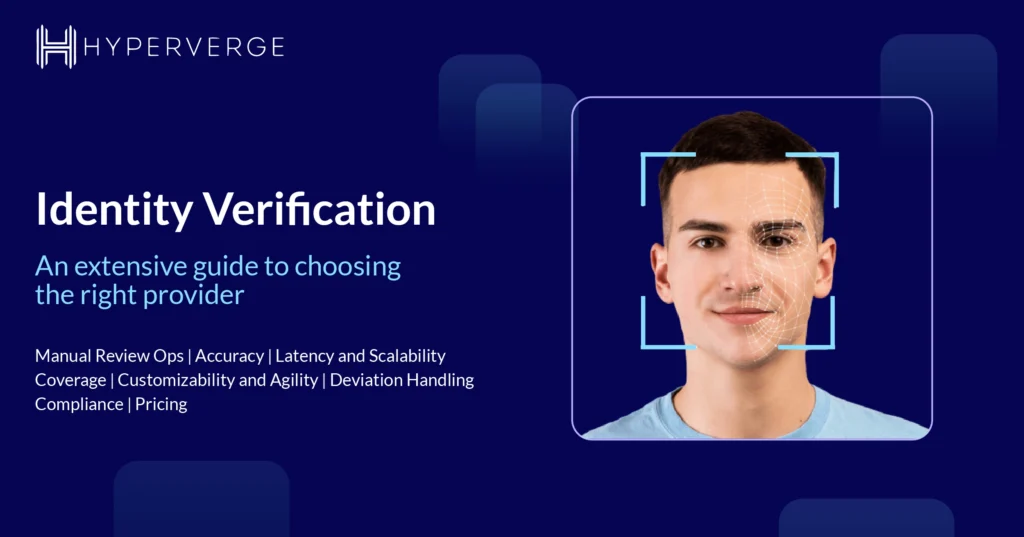How To Choose The Right Identity Verification Solution?
In today’s digital age, more business proceedings are occurring online. Customers conduct business remotely without being present physically, creating new problems for companies. Companies are tasked with the action of doing business with genuine customers by verifying the customer remotely. Due to compliance requirements placed on various industries like Payments, Securities, Banking, Crypto, etc, verifying the identities of the users during onboarding became mandatory.
What is Identity Verification?
Verifying an individual’s identity is becoming more and more common in a variety of business settings. An identity verification process is almost always required when you establish a bank account, withdraw money from a real-money gaming site, open a crypto account, or buy alcohol from an online site.
When it comes to the regulations that apply in different businesses and jurisdictions, there is a big variance in how strict the checks need to be. If you open a bank account anywhere in the world, you must pass a series of checks to ensure that the personal information you provide is true and that it is yours.
Customers’ information is then cross-referenced against a variety of reliable, high-quality data sources to arrive at a confidence score, which determines whether or not they are successfully onboarded.
Which industries require identity verification?
All industries can benefit from having a good identity verification process, but it is especially important for certain industries like:
1. Digital lenders
2. Crypto
3. Brokerages / investment apps
4. Remittance apps
5. Real money gaming/esports
6. Gig economy: Ride-sharing, e-Grocery, freelance & rental marketplace,
7. Wallets
8. Telecom
9. Banks
There are many companies that provide identity verification solutions in different ways, and it can be difficult to tell how these companies differ. When considering multiple identity verification vendors, there are a number of factors to examine, each of which will have varying degrees of importance depending on your use case, industry, and platform dynamics. While looking for an Identity Verification solution, keep the following factors in mind to figure out which option is best for you.

0. Manual Review Ops: In-House or Outsourced
Why this matters:
No IDV system can be 100% accurate. Manual review is needed for a fraction of edge cases. The decision to keep manual review in-house or outsourced will impact a lot of downstream variables in the design of your KYC workflow.
How to decide:
If you already have an ops team handling edge cases for other offerings, then it’s a no-brainer to expand the scope of their work to include manual review of IDV edge cases. It is recommended to set up your own manual review teams as this is not only cost-effective, but also ensures you have more control on the review process.
1. Accuracy
Why this matters:
At scale, higher IDV accuracy ensures higher automation, reducing manual review costs and improving customer KYC experience and TAT.
How to evaluate:
Everyone claims high accuracy in their sales pitch. The best way to evaluate is to conduct a thorough POC with a large sample set (at least 500 samples) to get a realistic picture and compare the performance across providers. It also helps to have clarity on what matters to your business more: precision or recall. IDV providers should be able to tweak their engines accordingly for the POC. For Face Recognition accuracy, NIST’s FRVT benchmark is a globally accepted authority. So ensure to check your provider’s ranking on their public leaderboard.
2. Latency and Scalability
Why this matters:
At scale, especially at peak volume, systems with high latency and scaling issues can cause high backlogs and can affect customer experience. Any solution with average latency higher than 5-7 seconds will lead to a poor customer experience.
How to evaluate:
- For IDV providers who have a manual review layer: Latency and scalability is a major concern here, since these providers are bottlenecked on human bandwidth. Check for SLA on latencies, and ensure provision for high penalties in case of Service Level Agreement(SLA) breaches. Also do background checks with their clients to confirm history of SLA breaches.
- For purely API based IDV providers (manual review handled at your end): Latency of APIs is easy to measure during the POC. Important to check for peak load performance to see how the system scales with volume.
3. Coverage: ID types, and Racial Bias in Face Recognition
Why this matters:
The USA has a lot of ID templates used for IDV. For great customer experience, it is important for your IDV provider to support the most important ID types submitted by users. We have seen that DL and passports account for more than 80% of IDs submitted. It is also important for the IDV provider’s facial recognition solution to perform well across racial face types (some large tech companies have recently been criticized for racial biases in their face recognition products).
How to evaluate:
Check for the list of IDs supported, and also check ID-wise accuracies during POC. A lot of vendors use an OEM for OCR of ID cards, and we have found their accuracies to vary across templates. During POC, ensure a good mix of racial face types in the sample set, and evaluate performance for each face type.
4. Customizability and Agility
Why this matters:
Identity fraud is ever-evolving, and IDV providers need to constantly update their offerings to keep up with fraud MOs. It is important to choose an IDV provider who can work closely with your fraud teams to keep evolving the offering.
How to evaluate:
Check if IDV provider’s solution is built in-house or they outsource it to an OEM. If they use an OEM solution, it will be difficult for them to customize the offerings for your evolving needs. Also confirm if they can deliver custom modules if you provide training data. If this is important for your business, it helps to include this in the scope of your POC. During POC, check for TAT on building and deploying a custom module, and also effectiveness of built module.
5. Deviation Handling
Why this matters:
Ability to address issues and edge-cases quickly with your IDV provider can be make-or-break for your KYC offering.
How to evaluate:
Check if the provider has a robust ticketing system to log and track issues. Ensure provision of SLA for response/resolution times, escalation matrix, and penalties for SLA breach.
6. Compliance: PII security, Data Storage and Privacy
Why this matters:
Since IDV involves processing PII data, events like data breaches or lawsuits for non-compliance can cause huge liabilities.
How to evaluate:
Check for systems and practices around PII handling, InfoSec audits, and compliance with relevant regulations like BIPA and CCPA. Also important to check if all data processing happens within the USA, since some IDV providers have manual verification teams sitting in offshore locations. This further adds to risk of data breaches. Some IDV providers also store PII information on their systems for long durations – important to ensure they don’t do this, and to have this covered in your contract.
7. Pricing:
Finally, for your KYC offering to be competitive, it is important to work with an IDV provider who can offer the most affordable price per API call.
While there is no simple answer to what is the right choice for any organization, a selection process should ultimately optimize for receiving the highest value at the lowest cost, which includes not only the cost of the solution, but also the cost of purchasing, the cost of integration, the cost of operation, the cost of lost business due to poor conversion, and the cost of lost value due to missed fraud. This is a multi-faceted issue that differs from one company to the next.
At HyperVerge, we strive to provide the most optimal solution for enterprises in various industries. Our IDV solution has the highest accuracy amongst all our competitors and we ranked in the top 10 in NIST FRVT benchmarking. If you are ready to take the leap with HyperVerge, come talk to us!







